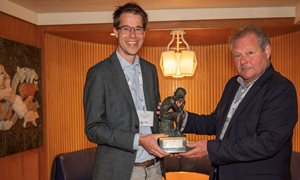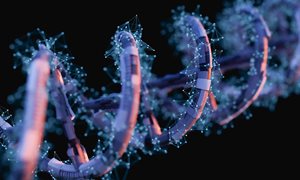 For the first time, researchers have uncovered that bad breath can be caused by a genetic defect. A mutation in the gene SELENBP1 leads to the absence of the protein that converts the sulphur compound methanethiol. Researchers from Radboud University and Radboud university medical center have published these findings in Nature Genetics.
For the first time, researchers have uncovered that bad breath can be caused by a genetic defect. A mutation in the gene SELENBP1 leads to the absence of the protein that converts the sulphur compound methanethiol. Researchers from Radboud University and Radboud university medical center have published these findings in Nature Genetics.
Bad breath (halitosis) is usually caused by bacteria in the oral cavity that produce sulphur compounds. Little is known about other causes of bad breath, but it has long been thought that it might also have a genetic cause. In the nineties, Dr. Albert Tangerman (Radboud university medical center, Dept. of Internal medicine) discovered a Dutch family with several members having bad breath. Together with Professor of Inborn errors of Metabolism Ron Wevers, he looked for a cause. They came across sulphur compounds, including the foul-smelling methanethiol. This compound gives rise to a strong cabbage-like odour. “Methanethiol is produced in large amounts in the intestines, and can originate from food. We believed that the protein responsible for getting rid of methanethiol was defective in these patients”, says Wevers, “however, we could not find a lead for this in their metabolism. The process by which the body counteracts this compound was unknown. So at that point we were stuck.”
From bacterium to human
Wevers presented this problem at several conventions and as a result was contacted by families from Germany and Portugal with the same problem. In addition, a collaboration with Microbiology Professor Huub Op den Camp, a specialist in sulphur conversion in bacteria, was established. Together with researchers from University of Warwick, they recently discovered a protein in the bacterium Hyphomicrobium that converts methanethiol: methanethiol oxidase.
The bacterium feeds on contamination in sewage, including sulphur compounds like methanethiol, removing them from the water. The researchers then looked to see whether the gene encoding the methanethiol oxidase protein in the bacteria was also present in humans. The human gene that corresponded most closely was SELENBP1. Huub Op den Camp: But the function of the corresponding human protein SELENBP1 was unknown. This also meant we did not know which compounds our body converts methanethiol into. The gene SELENBP1 is reported in the literature to be involved in tumour suppression. However, we immediately hypothesized that the absence of this protein could be the cause of bad breath in these patients.”
Widely distributed defect in metabolism
Wevers and Op den Camp investigated the breath, blood and urine of these patients, and found an increased amount of methanethiol and dimethyl sulphide. Wevers: “That was a direct clue that in these patients’ metabolism an error occurs, leading to the accumulation of four sulphur compounds, including methanethiol, in their blood. Methanethiol and dimethyl sulphide are extremely volatile and are thus easily exhaled via the lungs. Because we had now identified the human protein converting methanethiol, SELENBP1, we looked at these patients’ DNA. We found they all had mutations in the gene SELENBP1.”
Further research produced more evidence for this new discovery. For example, these patients’ skin cells had significantly lower levels of the protein and showed little or no enzyme activity. This same pattern was found in knock-out mice. This led to the conclusion that SELENBP1 is indeed a methanethiol oxidase and that mutations in this gene cause chronic bad breath. This mutation might be more common than we think: the researchers calculated that about 1 in 90,000 people carry the mutation. No cure is available for these patients. For the present, they can reduce bad breath only by dietary measures. Further research will focus on the development of a possible therapy, and on the role of compounds deriving from methanethiol in a healthy metabolism.
Publication
Mutations in SELENBP1, encoding a novel human methanethiol oxidase, cause extra-oral halitosis, Nature Genetics.
Related news items

Dutch Society of Clinical Chemistry Science & Innovation Award for the team of Hans Jacobs
14 June 2022 The team of Hans Jacobs pioneers on the development of personalized diagnostics to measure minimal residual disease in patients with multiple myeloma. go to page
New genetic defect links cell biology and protein glycosylation
10 November 2021 Peter Linders, Dirk Lefeber and Geert van den Bogaart together with international colleagues have recently reported on novel cell biological insights, by identifying a genetic disorder in syntaxin-5 which allowed to unravel a new mechanism regulating intracellular transportation. go to page
Tiny blood vessels, big problems Radboudumc receives grant for international collaboration
3 November 2021 The Radboudumc, together with the University of Cambridge, receives a grant of €1.8M from three collaborating cardiac foundations for international research into the small blood vessels in the brain. This study will be led by Neurologist Frank-Erik de Leeuw and internist Niels Riksen. go to page
Infections increase risk to develop dementia
16 September 2021 In a recently published study, Radboudumc researchers investigated the effects of infectious events on cognitive decline and the development of dementia and its possible structural underpinning using pre- and post-infection MRI of the brain. go to page
2.5 million Euros for cancer research into ovarian cancer and immunotherapy
15 April 2021 The Radboudumc receives 2.5 million Euros from the Dutch Cancer Society (KWF) for three studies to ensure oncological progress during COVID-19 period. go to page
A low cholesterol level is not a good thing
21 June 2018Research shows that low cholesterol can also be harmful. Researchers from Radboudumc and their Australian and American colleagues discovered a new metabolic defect, producing very low cholesterol levels. This causes brain anomalies, developmental delay, epilepsy and typical facial deformities.
go to page